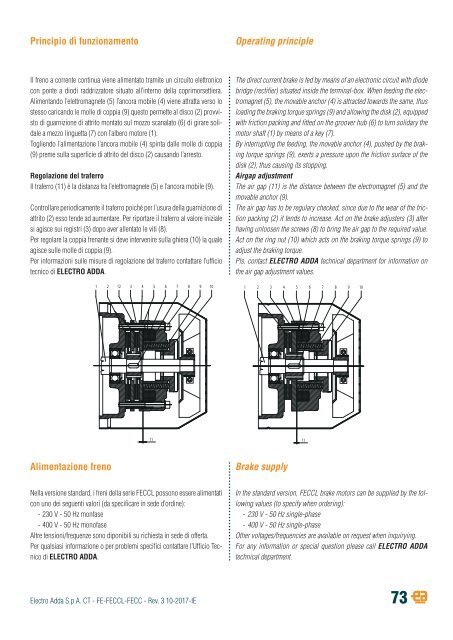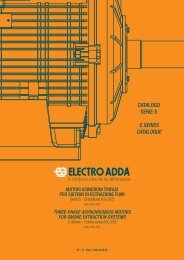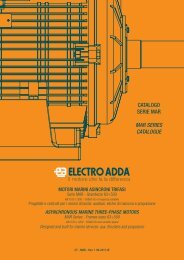Create successful ePaper yourself
Turn your PDF publications into a flip-book with our unique Google optimized e-Paper software.
Principio di funzionamento<br />
Operating principle<br />
Il freno a corrente continua viene alimentato tramite un circuito elettronico<br />
con ponte a diodi raddrizzatore situato all’interno della coprimorsettiera.<br />
Alimentando l’elettromagnete (5) l’ancora mobile (4) viene attratta verso lo<br />
stesso caricando le molle di coppia (9) questo permette al disco (2) provvisto<br />
di guarnizione di attrito montato sul mozzo scanalato (6) di girare solidale<br />
a mezzo linguetta (7) con l’albero motore (1).<br />
Togliendo l’alimentazione l’ancora mobile (4) spinta dalle molle di coppia<br />
(9) preme sulla superficie di attrito del disco (2) causando l’arresto.<br />
Regolazione del traferro<br />
Il traferro (11) è la distanza fra l’elettromagnete (5) e l’ancora mobile (9).<br />
Controllare periodicamente il traferro poiché per l’usura della guarnizione di<br />
attrito (2) esso tende ad aumentare. Per riportare il traferro al valore iniziale<br />
si agisce sui registri (3) dopo aver allentato le viti (8).<br />
Per regolare la coppia frenante si deve intervenire sulla ghiera (<strong>10</strong>) la quale<br />
agisce sulle molle di coppia (9).<br />
Per informazioni sulle misure di regolazione del traferro contattare l’ufficio<br />
tecnico di ELECTRO ADDA.<br />
The direct current brake is fed by means of an electronic circuit with diode<br />
bridge (rectifier) situated inside the terminal-box. When feeding the electromagnet<br />
(5), the movable anchor (4) is attracted towards the same, thus<br />
loading the braking torque springs (9) and allowing the disk (2), equipped<br />
with friction packing and fitted on the groover hub (6) to turn solidary the<br />
motor shaft (1) by means of a key (7).<br />
By interrupting the feeding, the movable anchor (4), pushed by the braking<br />
torque springs (9), exerts a pressure upon the friction surface of the<br />
disk (2), thus causing its stopping.<br />
Airgap adjustment<br />
The air gap (11) is the distance between the electromagnet (5) and the<br />
movable anchor (9).<br />
The air gap has to be regulary checked, since due to the wear of the friction<br />
packing (2) it tends to increase. Act on the brake adjusters (3) after<br />
having unloosen the screws (8) to bring the air gap to the required value.<br />
Act on the ring nut (<strong>10</strong>) which acts on the braking torque springs (9) to<br />
adjust the braking torque.<br />
Pls. contact ELECTRO ADDA technical department for information on<br />
the air gap adjustment values.<br />
Alimentazione freno<br />
Brake supply<br />
Nella versione standard, i freni della serie <strong>FE</strong>CCL possono essere alimentati<br />
con uno dei seguenti valori (da specificare in sede d’ordine):<br />
- 230 V - 50 Hz monfase<br />
- 400 V - 50 Hz monofase<br />
Altre tensioni/frequenze sono diponibili su richiesta in sede di offerta.<br />
Per qualsiasi informazione o per problemi specifici contattare l’Ufficio Tecnico<br />
di ELECTRO ADDA.<br />
In the standard version, <strong>FE</strong>CCL brake motors can be supplied by the following<br />
values (to specify when ordering):<br />
- 230 V - 50 Hz single-phase<br />
- 400 V - 50 Hz single-phase<br />
Other voltages/frequencies are available on request when inquirying.<br />
For any information or special question please call ELECTRO ADDA<br />
technical department.<br />
Electro Adda S.p.A. CT - <strong>FE</strong>-<strong>FE</strong>CCL-<strong>FE</strong>CC - Rev. 3 <strong>10</strong>-<strong>2017</strong>-<strong>IE</strong><br />
73






